Here’s the first part of a post about a house Jim and I bought in the summer of 2005. It’s one of a (not very) regular series of posts about gardens and houses we’ve owned over the years. (Being so very historic, you’ll need to excuse the quality of these pre-digital photos – or don’t, if you’d rather not).
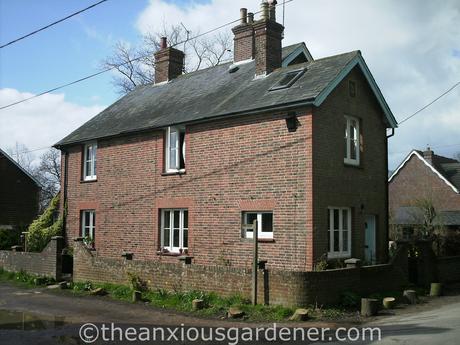
Digital image
" data-orig-size="2816,2112" data-image-title="Digital image" data-orig-file="https://theanxiousgardenerdotcom.files.wordpress.com/2017/03/we-made-a-garden-38.jpg" data-image-description="" data-image-meta="{"aperture":"3.3","credit":"","camera":"6MP-9Y8","caption":"Digital image","created_timestamp":"1205486526","copyright":"","focal_length":"7.3","iso":"50","shutter_speed":"0.0018552875695733","title":"Digital image","orientation":"1"}" data-medium-file="https://theanxiousgardenerdotcom.files.wordpress.com/2017/03/we-made-a-garden-38.jpg?w=300" data-permalink="https://theanxiousgardener.com/2022/02/13/we-made-a-garden-part-1/digital-image/" alt="Digital image" class="wp-image-26421" data-large-file="https://theanxiousgardenerdotcom.files.wordpress.com/2017/03/we-made-a-garden-38.jpg?w=676" />By the spring of 2006, we’d installed two Velux windows and a sun pipe in the roof. I’d also planted the hornbeam whips and, of course, added a black bat box on the wall.Here’s the house about six months after we moved in. It had been a cold, neglected and unloved little cottage but, after we’d been there a while, we liked to call it home. (At the time of purchase, I didn’t know that almost opposite, hidden in the lightly wooded valley below, down a long wooded driveway lay the Priory. I would become her gardener three years later).
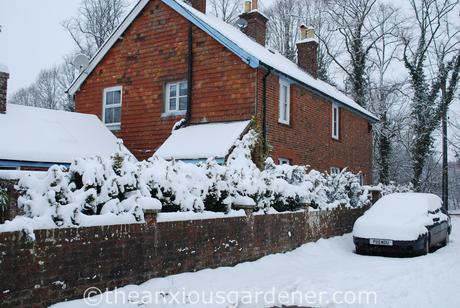
In winter, heating of sorts, came from unwilling-to-give-up-their-warmth night-storage heaters, open fires and a marvelous 1950s Rayburn solid fuel range.
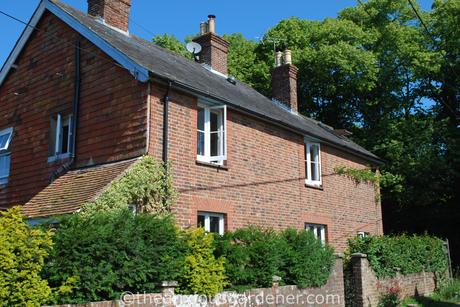
But in spring and summer, the house was a fine – warm – place to live and for the first time, after living in London, Bristol and Brighton, I fulfilled a life-long dream: living in the country. Unlike town life, we met and got to know all of the neighbours… and most of them, we liked.
Wrapped about the northern end of the house, facing the road, I planted a hornbeam hedge inside the garden wall – as hornbeam isn’t too picky and doesn’t mind shade. On the eastern side, lining an unmetalled lane, I switched from hornbeam to yew. The hornbeam came as whips, the yew as large pot-bound trees – bought cheaply second hand – and neither took long to establish and provide some privacy against the nosey folk. The above photo was taken in 2008, probably.
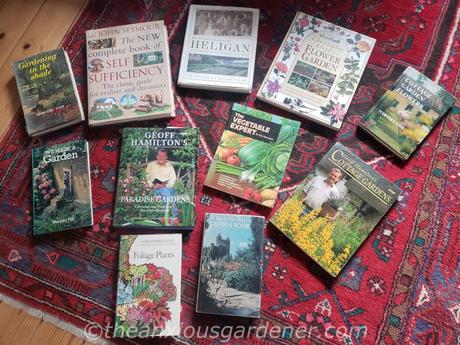
We were both new to gardening, pretty clueless actually, and I trawled charity shops and second hand bookshops, sweeping up ‘How to Garden’ books by Geoff Hamilton, Christopher Lloyd, Margery Fish and the like. I bought gardening videos from charity shops too and watched, bewildered, as very smiley people explained how easy it is to prune clematis or grow pelargoniums; how terribly simple to plan big seasonal-interest borders; how straightforward to first build and then sow and crop vegetable beds. None of this seemed particularly easy or simple to me. But then, I’d stumbled into a vast and smiley world of strange expertise and Latin names; of pH and soil types; of grafting and pruning; of annuals and perennials and biennials; of seed sowing and cuttings; and, and… stuff. Just loads and loads of new stuff.
Reader, I was a bit overwhelmed.
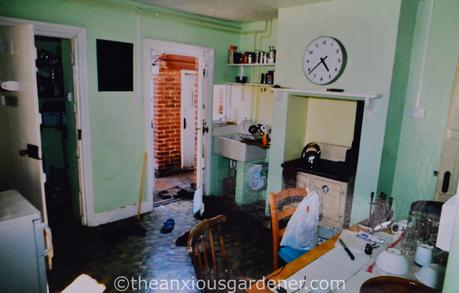
So, initially, we concentrated instead on the house. Like every property we’ve bought, this cottage was to be a Project. (Btw, there’s that cream-coloured Rayburn I just mentioned. It was difficult to master but when we understood its foibles and demanding nature, it became central to our cold, wet and muddy life. The Rayburn heated the kitchen and most of the downstairs, gave us scalding hot water, cooked most of our food and warmed our buns. One of my life’s proudest achievements was keeping it alight, non-stop, for three winter months).
Before us, an elderly lady had rented the house from an unpleasant London Company and they, having only recently bought the freehold, did little to improve her lot. It took us a while to locate the source of a curious and nasty smell in the kitchen. A smell of vomit, to be frank. She’d complained about it, apparently, to no avail but we soon discovered the source and it was easy enough to fix – had the unpleasant London Company bothered to help their elderly, sickly tenant. Water was leaking from the butler’s sink, puddling beneath the linoleum, turning sour and stinky.
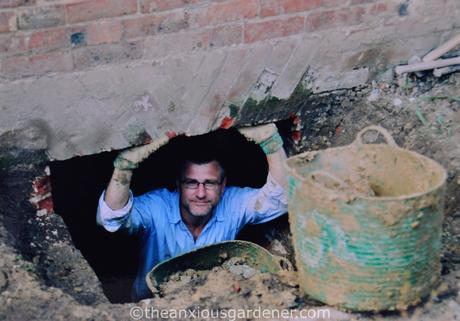
One day, sink sorted, kitchen painted, Jim was weeding along the side of the house and noticed angled bricks at ground level, similar to those above all the windows. Did the house have an underground window? Neither the property details nor surveyor had mentioned that the house had a cellar. And you’d think that an unknown room, an unknown extra floor, might be the sort of thing they’d point out.
Intrigued and excited, I ran to a neighbour’s, borrowed a sledgehammer and, Thor-like, pounded a hole through the only wall, in an under-stair cupboard, which could possibly conceal a staircase. Eventually, a bit sweaty, a bit breathless, not very Thor-like, I’d made a hole big enough to peek through. By torchlight, I saw, receding into the gloom, a flight of stairs. Yeah, I did. I really did. And I probably squealed at that point. Yeah, I probably did squeal, actually.
I whacked at the hole until we could squeeze through and venture down the steps into a large brick-floored cellar – with, sure enough, a bricked-up window. No treasure chest, no skeleton chained to a wall, no ghostly dancing lights… but hey, an extra room is always going to be a good enough find, even if the ceiling wasn’t high enough to stand upright.
Over the next few weeks, I levered up every brick from the non-cemented floor and carried them up the stairs, through the kitchen and all the way out to the back garden. We knocked out the bricked-up window and dug out clay to a further depth of twelve inches, passing it out through the window to a waiting skip. And yes, you’re right. That was a big job. Eventually, we laid a new concrete floor and tanked the walls to make it all watertight. (We think it had been bricked up historically because it was just too darn wet).
I sometimes dream of finding an undiscovered room in my house, or better still, an entire dusty, unused wing, but, to date, this is the only time it happened for real. Have you ever bought or rented a property and discovered a hidden room or rooms? Do tell.
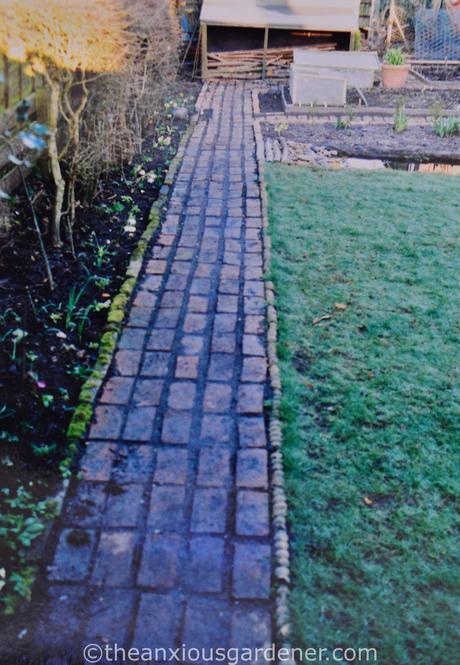
I repurposed the cellar bricks as pathways, many pathways, in the rear garden.
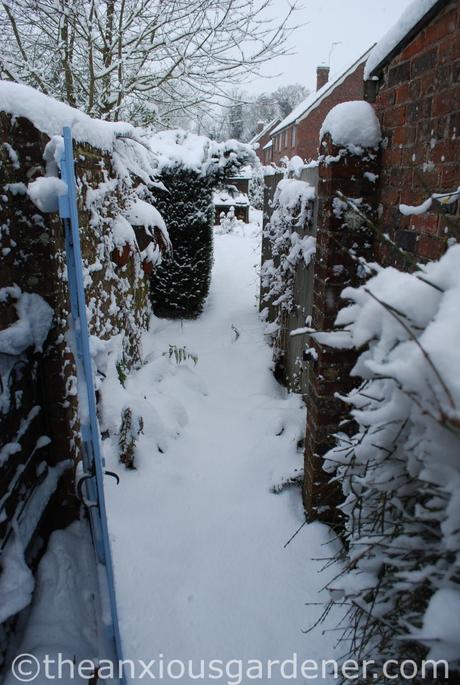
This rear garden, the main garden to the cottage, was some way away: across a smaller garden behind the house, then hang a right, open the pale blue gate and pass down a narrow passage. Later, I planted this shady little passage with ferns and named it, imaginatively, the Fern Walk. Jim looked at me for a moment and called me a pretentious knob. Which, in fact, was fair.
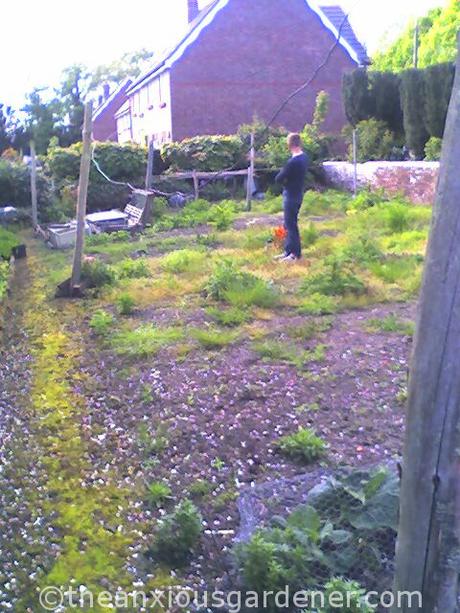
It was this larger, main garden that clinched the house-deal for us. If we were going to live in the middle of nowhere, comparatively, we needed a biggish garden. We wanted chickens, we wanted log stores, a coal bunker, fruit trees. We wanted to grow vegetables, we wanted to be Tom Good. Or Barbara. The previous owner grew her vegetables here and, for decades, she’d dug in compost and she’d dug in manure. We looked skyward and humbly thanked her. The soil was rich and crumbly and sweet smelling. But, as her health deteriorated, tending a big kitchen garden became too much for her and the plot slipped into neglect.
The photo above was taken on the day we first viewed the house in the spring of 2005. But by the time we moved in, it was waist high with grass, dock, nettle and bramble.
I’ll show you what we did with it next time.

